💉 Reproduction
Mating System, System of breeding, Artificial Insemination
Which of the following statment/s is/are wrong?
Mating System
- Natural Mating: mating by natural means.
- Artificial Insemination (AI): mating through artificial means.
System of breeding
Breeding
- The mating and production of offspring by animals is known as breeding.
- Scientific breeding is needed to get better performance in livestock – milk – meat – wool – Egg.
Inbreeding
- Mating of
closely relatedanimals in the same breed within 4 generations this results in inbreeding. - Advantage:
- Inbreeding increases the genetic purity. Therefore a pure line of a particular breed can be maintained.
- Disadvantage: Loss of vigour, size, production and fertility problems. (Inbreeding depression)
- There are two types of inbreeding:
- Close Breeding
- Line Breeding
Close breeding
- This is most intensive breeding where animals are very closely related and can be tracked back to more than one common ancestor.
- Example:
- Sire to daughter/son to dam/brother to sister.
- Sire: The male parent in a cross.
- Dam: The female parent in a cross.
Line breeding
- Mating animals that are more distantly related which can be traced back to one common ancestor.
- Example: Cousins Grandparents to grand offspring, Half – brother to half-sister.
- Line breeding increases genetic purity amongst the animals of progeny generations.
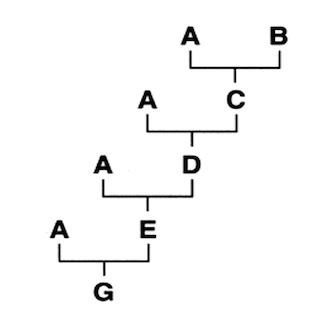
Out Breeding
- Breeding of the unrelated animals which may be between individuals of the same breed but no common ancestors, or between different breeds or different species.
- It is of following types:
- Out Crossing
- Cross Breeding
- Species Hybridization
- Grading-up
Out Crossing
- It involves mating between unrelated members of the
same breedwhich have no common ancestors on either side of their pedigree up to 4-6 generations. - The offspring of such a mating is known as an outcross.
Cross Breeding
- This is mating of animals from the
two different established breeds. - Eg. Jersey x Kangayam, Jersey x Holstein Friesian etc.
- The cross bred animals will exhibit the mixture of qualities of both the parents breeds. The progeny will improve in production performance and will exhibit marked disease resistance characteristics of the native breed and is well adapted to with stand local climatic condition.
- Superior traits that results in the crossbred progeny from crossbreeding are called hybrid vigour or heterosis.
62.5 %of exotic blood &37.5 %local blood is considered ideal.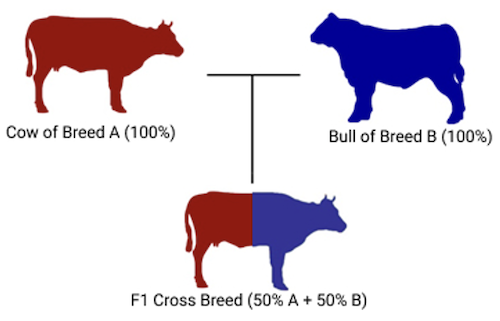
- Cross breeding is the best method for increasing the milk yield and growth rate in beef cattle.
- All India Coordinated Research Project on cattle resulted in development of synthetic breeds like Karan Swiss, Karan Fries, Frieswal, and Sunandini etc.
- It contributed to make India to stand first in milk production in the world.
Criss-Cross Breeding
- When two well eshtablised breeds that has been crosses alternatively then it is called
Criss-Cross breading. - When males from the pure breeds are used in alternate generations to breed the cross bred females is known as
Rotational Crossing. - Rotational crossbreeding, sometimes referred to as sequence breeding, is when males of two or more breeds are mated to crossbred females. Over a number of years, each breed will have contributed its strengths and weaknesses equally.

- This rotational crossing could be between two breeds is called crisscrossing and among three breeds is called
triple crossing. - Cross breeding is the system of breeding mostly used for genetic improvement of cattle whereas Grading up is the method used for genetic improvement of the buffalos.
Grading up
- Grading up is the breeding of animals of two different breeds where the animals of an indigenous breed/generic group is mated by an improved pure breed for several generations towards attaining the superior traits of the improved breed.
- Non-descript cow x Jersey Bull
- F1: 50% ND + 50% Jersey x Jersey Bull
- F2: 25% ND + 75% Jersey x Jersey Bull
- F3: 12.5% ND + 87.5% Jersey x Jersey Bull
- After 5-6 generations the off springs will have 96.9% & 98.3% of the hereditary characters of “Pure Breed‟.
👉🏻 So grading is a process by which a few “Pure Breed” sires can rather quickly transform local variety of animals into a “Group” resembling the pure breed.
- Grading up is the system of breeding mostly adopted for genetic improvement of the buffaloes.
- It is to be taken up in areas having more number of the non-descriptive female population.
- E.g. Godavari breed of buffalo is developed by crossing of the local buffalos of coastal region of Andra Pradesh breed with Murrah breed over several generations.
Back Crossing
- When F1 hybrid is crossed with either homozygous dominant or heterozygous genotypes, it is known as Back Cross.
- The mating of a crossbred animal back to one of the pure parent races which were used to produce it.
- This breeding method is not commonly used by breeders but only used in genetic studies.
Species Hybridization
- Mating of male and female animals of two different but related species is known as species hybridization.
- The progeny may combine desirable features of both the parents species, which may be of considerable economic value.
- E.g., Mule (Donkey ⚦ and Mare ♀).
Economic Traits of Dairy Cattle
- Age at 1st calving: The desirable age at first calving in Indian breeds is 3 years,
24 to 30 monthsin cross breed cattle and 3.5 years in buffaloes.
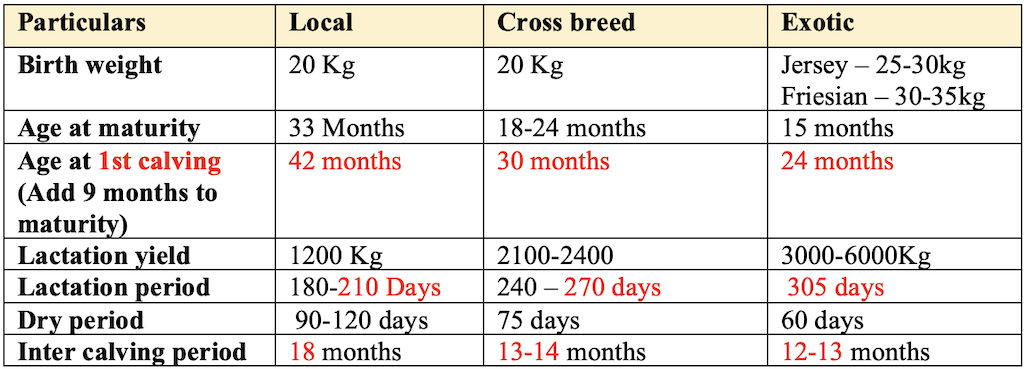
- Lactation Period: Days in milk from the date of calving to the final drying off or cessation of milk (
305 days). - Lactation Yield:
- Milk yield in Kgs from the date of calving to the date of drying (lactation period).
- The optimum lactation period is
305 days.
- Peak yield:
- The highest daily yield in Kgs during lactation period.
- After parturition, the milk yield per day will be increased and reaches peak within 2 to 4 weeks after calving. This yield is known as peak yield.
- After 3 or 4 lactation, the production starts declining.
- Dry period: Days from the date of drying to the date of next calving.
- Inter calving period:
- Interval from the date or one calving to the date of next calving (1st & 2nd).
- It is more profitable to have one calf yearly in cattle and at least one calf for every 15 months in buffaloes.
- Average Fat %:
- Sheep (7.90%) > Buffalo (7.38%) > Goat (4.25) > Cow (4.14%)
- Exotic > Cross Breed > Indigenous Cattle
- Service period:
- The period between parturition to successful conception expressed in days is known as service period.
- Optimum service period is
60 to 90 days.
- Service: This term indicates the process in which mature male covers the female.
- Breeding efficiency: Measured as the No. Services per Conception.
- Conception rate is the measure of animal’s fertility at service or the successful union of male and female in reproduction process.
- Gestation period: The period from conception to delivery of a female animal is called gestation period. Or is the period of pregnancy in animals.
- Parturition: This term indicates the act of giving birth to young one.
Selection of Breeding Animals
- It is better to purchase the animals during the month of October and November.
- Maximum yield is noticed till 90 days after calving.
- Cross-breed animals with exotic inheritance of about 50 percent are preferable.
- Culling: Removal of undesirable or unproductive animals from herd.
Selection for Milk Production
- The present average daily milk production of the cross breed cows is around 5.5 liters.
- For economic milk production a cow producing not less than 2500 kg milk in 305 days lactation period is desirable.
- In general, selecting a newly calved cow yielding 10 liters per day may have 2000-2500 kg lactation yield and cow yielding 15 liters per day initially may have a lactation yield of 3000 kg.
- A peak yield of at least 12 kg milk per day can be used as a criterion for this.
- Age at first calving should be less than 12 to 15 months.
Reproductive System
Puberty
- The stage of the female in which the ovary is fully developed, and the process of egg formation begins in it.
- At this stage the female becomes pregnant.
Cryptorchid
- A male animal with one or both the testicles retained inside the abdominal cavity is called as Cryptorchid.
- Means undescended testicle in the scrotal sacs.
Free Martin
- When twin calves of different sexes are born, the bull calf is normal whereas the heifer calf is sterile with masculinized behaviour and non-functioning ovaries.
- The sterile heifer calf is called freemartin.
Teaser bull
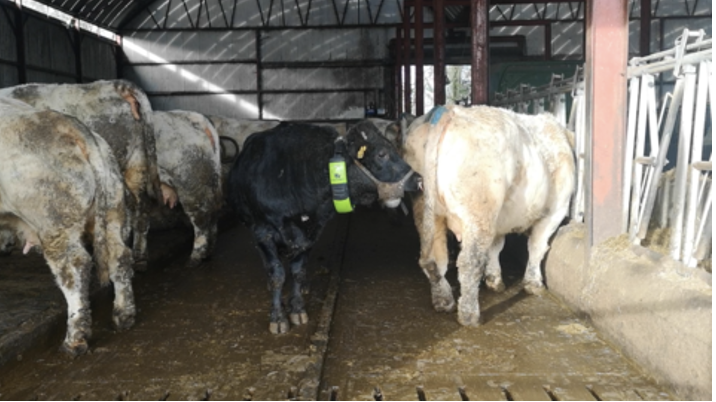
- A teaser bull is a term describing a bull whose reproductive system has been surgically altered to render him sterile.
- The bull is sterilized by either vasectomy or caudal epididymectomy.
- The purpose of such bulls is to aid in detection of cows in estrus or in heat period to facilitate when to artificially inseminate.
Stud Bull
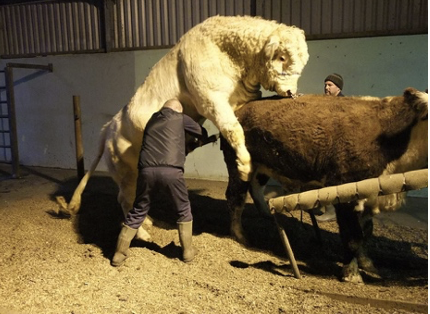
- Bull that is used for
breeding purposes.
Scrub Bull
- A bull which does not have good progeny record non-descriptive bull.
- It is a non-descript type of stray village cattle.
Steer
- The castrated male dairy/beef animal.
Estrus Cycle
- The physical events between two heating periods are called Estrus cycle.
- During this period, animals provide a safe environment in their body for embryo development by conceiving.
- Estrus period: The state in which a female animal is willing to mate with a male.

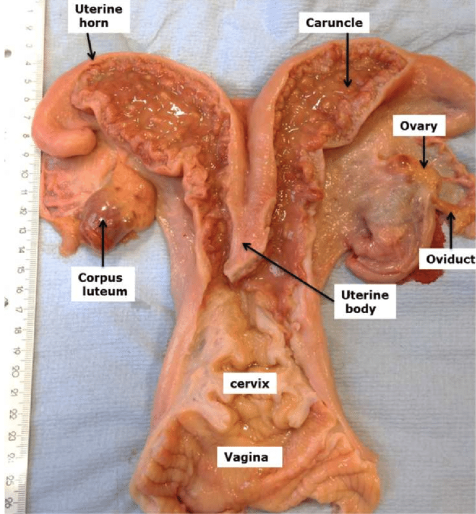
Figure: Cow Uterus Credits: Zeravan A. Mohammed
Symptoms of Heat
- Off feed
- Drop in milk yield
- Restless and excited
- Bellowing
- Oedema / swelling of genitalia
- Frequent urination
- Transparent mucous discharge
- Cow/buffalo which are in heat will mount on other animals and allows mounting of other animals.
Phases of Estrus Cycyle
- Proestrum
- Duration: 2 days
- Period of building up growth of graffian follicle which helps for the nourishment of ovum fluid contains hormone called
estrogen. - It causes changes in uterus blood supply. [
Heat Period]
- Estrum:
- Duration: 1 day
- During which the female is ready to receive male. [
Desire Period] - The release of the mature ovum from the ovary is called
ovulation.
- Metoestrum:
- Duration: 4 days
Implantationof the embryo takes place.Corpus Luteumtakes place. It prevents the growth of graffian follicle thereby arrests oestrus cycle.- Corpus luteum: It is a hormone-secreting (endocrine)structure that develops in an ovary after an ovum has been discharged but degenerates after a few days unless pregnancy has begun. It secrete
progesteronehormone. - A pregnant cow does not come in heat because of presence of Corpus luteum.
- Diestrum:
- Duration: 14 days [
Longest Period] - Further development of uterus takes place.
- If the animal has not conceived
involutionof uterus takes place.
- Duration: 14 days [
- Involution: It is the process where pregnant cow’s uterus (womb) returns to the way it was before pregnancy.



Hormones
- Estrogens: Released by
Grafina follicle. It is a sex hormone. - Progesterone: Released by
Corpus luteum. It is a sex hormone. - Gonadotropin-releasing hormone (GnRH):
- Secreted by
hypothalamusof the brain. - It is responsible for the release of follicle-stimulating hormone (FSH) and luteinizing hormone (LH) from anterior pitutary gland.
- Secreted by
Optimum Time for Crossing
- Egg/ova from ovary – released about 12 - 18 hours after the onset of symptoms of heat.
- Ovum will survive upto 16 hours after the release.
- Sperm live for 12-14 hours.
- Morning signs of heat are exhibited – insemination or mating should be done in the evening i.e. 12 hours delay.
Artificial Insemination
- Artificial insemination is the deposition of male reproductive cells (sperm) in the female tract by mechanical means rather than “Natural Service”.
- Maintinance of hygienic conditions is most important.
- The best site for semen deposition during artificial insemination in cattle is
mid-cervix.
Artificial Vagina
- Internal temperature of artificial vagina is around
40-45°C.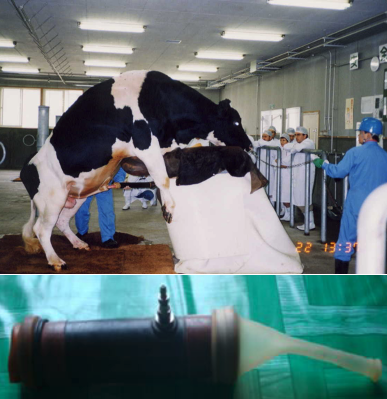
Advantages
- Increases usefulness of superior sires to extra ordinary degree.
- Services of Superior Sires are greatly extended.
- If the sires are used for Natural Service the animal can serve only 50-60 animals/year but under Artificial Insemination the amount of semen secreted by the animal can be used to satisfy the requirements of 1000 animals per year.
Merits
- Semen can be stored in the frozen state, so progeny can be obtained even after the transfer, even after death of bull-15-20 years. (atomic, radioactive, X-ray unit)
- Frozen semen can be transported to destination once in a month from the semen bank.
- No need to maintain Breeding Bull. The frozen semen can be stored in the Liquid Nitrogen
-196 °C. - Spreading of diseases is absolutely - Nil.
- Overcomes the difficulty of size and weight between Dam and Sire.
- Increase the rate of Conception because in the artificial insemination the semen is being deposited in the mid cervix.
- Outstanding animals located apart can be mated.
- Helps in better record keeping.
Disadvantages
- Some bull’s semen may not freeze well.
- If inferior bull semen is frozen and used – Extensive damage is caused.
- Maintenance of frozen semen bank is not economical for a small area of operation.
- Requires well trained technical personnel’s and special equipments and hygienic measures are too adapted in preparation.
- Improper cleaning of instruments and unsanitary condition may lead to lower fertility and may be nucleus for the spreading of diseases.
Advanced Methods
- World First IVF buffalo calf:
Prathamdeveloped by NDRI, Karnal, Haryana. - National Dairy Research Institute, Karnal have developed the landmark technique i.e. “Hand guided Cloning Technique” and have produced the world’s first (died after birth) and second cloned buffalo calves.
- World’s First cloned buffalo calf:
Samrupadeveloped by NDRI, Karnal, Haryana. - World’s Second cloned buffalo calf:
Garimadeveloped by NDRI, Karnal, Haryana. - Cloned and surviving buffalo calf,
Garima, produced for faster multiplication of selected highly productive animals.
Explore More 🔭
🟢 https://www.youtube.com/watch?v=ayzN5f3qN8g
References
- G.C. Banerjee: A Textbook of Animal Husbandry
- https://www.dairyknowledge.in
- https://buffalopedianew.cirb.res.in/godavari/
- https://nbagr.icar.gov.in/
- https://www.nddb.coop/
- Wikipedia
Which of the following statment/s is/are wrong?
Mating System
- Natural Mating: mating by natural means.
- Artificial Insemination (AI): mating through artificial means.
System of breeding
Breeding
- The mating and production of offspring by animals is known as breeding.
- Scientific breeding is needed to get better performance in livestock – milk – meat – wool – Egg.
Inbreeding
- Mating of
closely relatedanimals in the same breed within 4 generations this results in inbreeding. - Advantage:
- Inbreeding increases the genetic purity. Therefore a pure line of a particular breed can be maintained.
- Disadvantage: Loss of vigour, size, production and fertility problems. (Inbreeding depression)
- There are two types of inbreeding:
- Close Breeding
- Line Breeding
Close breeding
- This is most …
Become Successful With AgriDots
Learn the essential skills for getting a seat in the Exam with
🦄 You are a pro member!
Only use this page if purchasing a gift or enterprise account
Plan
Rs
- Unlimited access to PRO courses
- Quizzes with hand-picked meme prizes
- Invite to private Discord chat
- Free Sticker emailed
Lifetime
Rs
1,499
once
- All PRO-tier benefits
- Single payment, lifetime access
- 4,200 bonus xp points
- Next Level
T-shirt shipped worldwide

Yo! You just found a 20% discount using 👉 EASTEREGG

High-quality fitted cotton shirt produced by Next Level Apparel